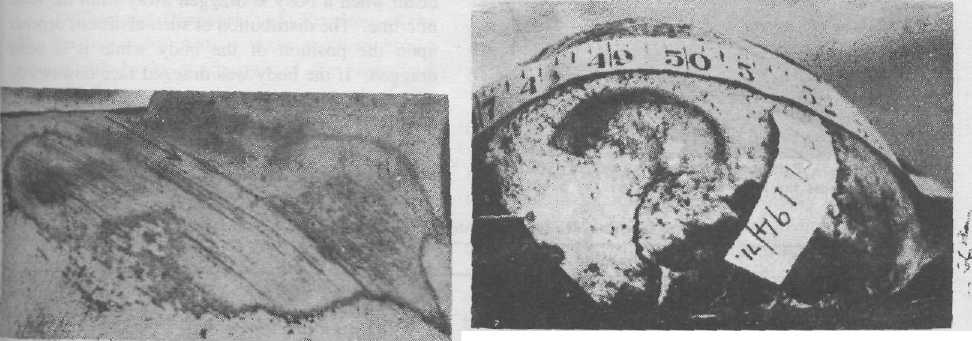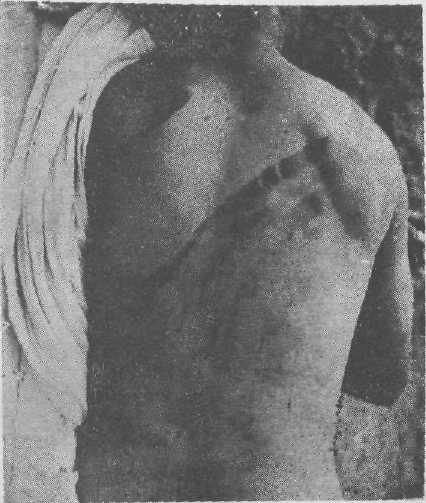
- •Mechanical injuries
- •Table (8-1). Difference between ante-mortem and post-mortem abrasions.
- •Contusions (bruises)
- •In interpreting the age of a bruise by colour changes, one should be very cautiousT)
- •Table (8-2). Difference between hypostasis and bruise.
- •Injury; may appear anywhere on the body.
- •Lacerations
- •If asleep, blood runs down on both sides of the neck and collects behind the neck and shoulder; stains found on both palms, for the victim attempts to cover the wound.
- •Incised wounds of the arms are almost always
- •Is repaired.
- •Table (8-5). Differences between suicidal, homicidal and accidental stab wounds
Vardanyan Sh.A.
Avagyan K.K.
Forensic medicine
Mechanical injuries
2006
MECHANICAL INJURIES
(An injury is any harm, whatever illegally caused to any person in body, mind, reputation or property (Sec. 44, l.P.C). Mechanical injuries (wounds) are injuries produced by physical violence. A wound or injury is a break- of the natural continuity of any of the tissues of the living body. The question of wounds may be raised in a Court of law in both civil and criminal cases.
Classification: (I) Mechanical Injuries: (1) Abrasions. (2) Contusions. (3) Lacerations. (4) Incised wounds. (5) Stab wounds. (6) Firearm wounds. (7) Fractures and dislocations.
(II) Thermal Injuries: (1) Due to cold: (a)
Frostbite, (b) Trench foot, (c) Immersion foot. (2)
Due to heat: (a) Burns, (b) Scalds.
(III) Chemical Injuries: (1) Corrosive
acids, (b) Corrosive alkalis,
(IV) Injuries due to electricity, lightning,
X-rays, radioactive substances, etc.
Legally, injuries are classified into: (1) Simple, and (2) Grievous, y
General Principles:1^, wound is caused by a mechanical force which may be either a moving weapon or object, or the movement of the body itself. \In the first case, the counterforce is provided by the inertia of the body, and in the second case by the rigidity of some stationary object against which he falls^A combination of these two events is seen in most cases. Due to the impact between the forward moving force and the counterforce, energy is transferred to the tissues of the body, which causes a change in their state of rest or motion. The human body contains many complex tissues which greatly vary in their physical properties, such as state of solidity, fluidity, density and elasticity, and because of this a change in the state of rest or motion of the body produced by a forceful impact does not affect the tisssues uniformly. Some of the energy is spent in moving the body as a whole, but most of the energy may cause non-uniform motion of localised parts of the body, due to which the affected tissues will be subjected to compression or to traction strains or to a combination of both. All the body tissues, except those which contain gas, are resistant to compression, i.e., they resist force tending to reduce their volumes. Mechanical force does not cause compression of the tissue but causes their displacement and deformation, and traction strains are produced in the affected tissues. Such strains may be due to forces causing simple elongation of tissues, but they may be due to more complex mechanism, such as bending, torsion or shearing. A shear strain is a strain which is produced in a body by the forceful alteration of its shape but not its volume. It causes or tends to cause two parts of a body in contact with each other to slide relatively to each other in a direction parallel to their plane of contact. Because of the great variation in the resistance of the different tissues to traction, they rupture with varying ease, as their cohesiveness is exceeded. The rigid tissues like bones resist deformation, but if the limits of their elasticity is exceeded fracture occurs.. The sofl tissues are plastic, and as such, mechanical force alters their shape, which is limited by the cohesion between the tissue cells, connective and vascular tissue frameworks and capsules of organs. Soft tissues rupture when they are stretched beyond the limits of their tensile strength-
ABRASIONS
An abrasion (gravel rash) is a destruction of the skin, which usually involves the superficial layers of the epidermis only. They are caused by a lateral rubbing action by a blow, a fall on a rough surface, by being dragged in a vehicular accident, fingernails, thorns or teethbite^j Some pressure and movement by agent on the surface of the skin is essential.In its simplest form, the epidermal cells are flattened and their nuclei are elongated. If sufficieni friction is applied, partial or complete removal of the epithelium may occur and the superficial layer of dermis is damaged. Many abrasions have some deeper areas of subepidermal damage which may result in superficial scarring. Sometimes, full thickness of the skin may be damaged in places, but usually in an interrupted, irregular manner, and intact epidermis remains within the area of the abrasion. The rougher the surface, and the more rapid the movement of the skin over it, the deeper is the injury. The exposed raw surface is covered by exudation of lymph and blood which produces a protective covering known as a scab or crust. Abrasions vary in size, depending on the extent of the body surface exposed to the abrading force. They are simple injuries, bleed slightly, heal rapidly and scar is not formed. Large abrasions can cause severe pain and bleeding. The size, situation, pattern and number of abrasions should be noted. Types : Abrasions are of four types.
(1) Scratches : They are caused by a sharp
or pointed object passing across the skin, such as
fingernails, pin or thorn. The surface layers of the
skin are collected in front of the object, which leaves
a clean area at the start and tags at the end. Sharp
fingernails produce a scratch which is usually
curved, one to 2 mm. in breadth, wide at the start
and narrow at the end. A thorn or pin produces
;i narrow scratch which tails off.
(2) Grazes (sliding, scraping or grinding
abrasion): They are the most common type. They
occur when there is movement between the skin and
some rough surface in contact with it. They show
uneven, longitudinal parallel lines (grooves or
furrows) with the epithelium heaped up at the ends
of these lines, which indicate the direction in which
the force was applied (fig.8-1). The presence of clothing will modify the appearance of abrasions. The furrow may be broad at one end, and narrow in the opposite direction. A glancing kick with a boot also produces a graze. These abrasions are commonly seen in a road accident. Many abrasions extend into the corium, because of the corrugations of the dermal papillae, and bleeding occurs. An abrasion caused by violent lateral rubbing against a surface as in dragging over the ground is called brush burn. "Friction burn" is an extensive, superficial, reddened excoriated area with little or no linear mark. It may occur when the skin is covered by clothing.
(3) Pressure Abrasions (crushing or friction
abrasions): They are caused by crushing of the
superficial layers of the epidermis and are associated
with a bruise of the surrounding area. If the
movement of instrument is around 90° to the skin,
a pressure type of abrasion occurs. In this type, the
movement is slight and largely directed inwards.
The ligature mark in cases of hanging and
strangulation and the teethbite marks are the
examples.
(4) Impact Abrasions (contact or imprint
abrasions) : They are caused by impact with a rough
object, when the force is applied at or near a right
angle to the skin surface. The abrasion is slightly
depressed below the surface, unless there is bulging
due to underlying contusion or local oedema. If

Fig (8-1). Abrasion indicating direction of force. Fig. (8-2). Abrasion of the skull due to tearing force produced by the automobile wheel causing avulsion of the scalp. the impact is forcible, the dermis is damaged with an underlying bruise. When a person is knocked down by a motor car, the pattern of the radiator grille, a headlamp rim or the tread of the tyre may be seen on the skin, which may contain road dirt, paint flakes, grease, etc. Impact by a solid object may produce abrasion at the periphery where the skin is forced downwards. Impact abrasions and pressure abrasions reproduce the pattern of the object causing it and are called patterned abrasions. Patterned abrasions are produced when the force is applied at right angle to the surface of skin. If the skin is struck with a weapon having a patterned surface, the ridges of the object damage the epidermis, and the skin may be compressed into the cavities of the pattern, causing intradermal bruise. Other examples of patterned abrasion are : imprint of bicycle chain,weave ofcoarse fabrics, the spiral of electric wires,
ropes, serrated knife, etc.

Patterned abrasion. Imprint of tyre tread across the back due to run over by a bus.
Age of the Abrasions : The exact age cannot
be determined. Fresh : Bright red. 12 to 24 hours : Lymph and blood dries up leaving a bright scab. 2 to 3 days : Reddish-brown scab, 4 to 7 days : Epithelium grows and covers defect under the scab. After 7 days : Scab dries, shrinks and falls off.
Histologically, perivasculav cellular infiltration is seen at four to six hours. At 12 hours three layers are seen : a surface zone of fibrin and red cells; a deeper zone of infiltrating polymorphs ; and a deepest layer of abnormally staining collagen. At 48 hours, scab is well-formed and epithelial regeneration is seen at the margins of the scab. By 4 to 5 days, small abrasions are completely covered by epithelium. By 5 to 8 days, subepithelial formation of granulation tissue is prominent. Reticulum fibres are seen at 8 days, and collagen fibres at 9 to 12 days.
Ante-mortem and Post-mortem Abrasions. Abrasions produced slightly before or after death cannot be differentiated even by microscopic examination. In superficial lesions or when decomposition is advanced, differentiation is difficult. After death, the abraded epidermis becomes stiff, leathery, and parchment-like, brown, more prominent and may be mistaken for burns. On drying, 1 abrasions become dark-brown or even black. In a body recovered from water, abrasions may not be seen on first inspection, but they are easily seen after the skin dries. Abrasions may be produced after death when a body is dragged away from the scene of crime. The distribution of such abrasions depends upon the position of the body while it is being dragged. If the body was dragged face downwards, linear abrasions may be produced on the front of the face, trunk and lower limbs,
Circumstances of Injuries : Abrasions are usually seen in accidents and assaults. Suicidal
